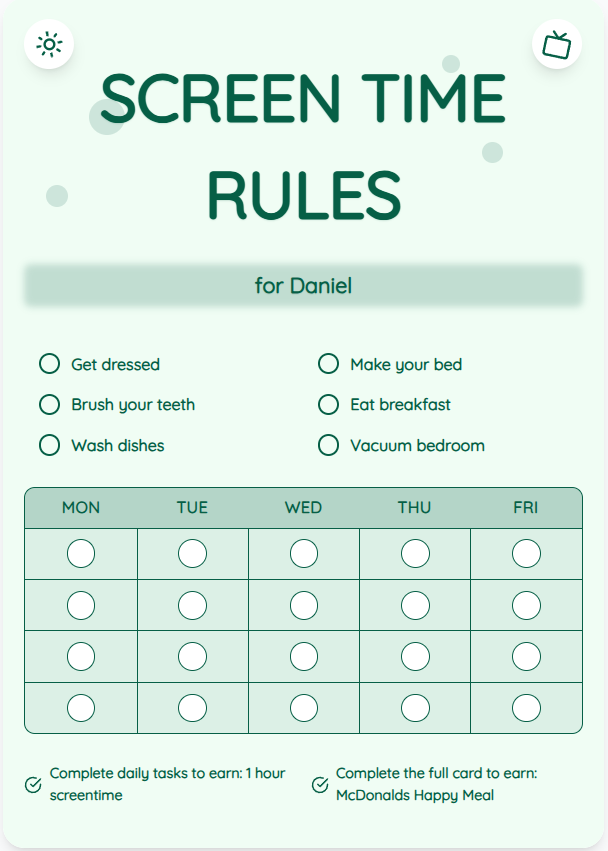Screen Time Out: A Parent's Guide to Balancing Screen Time for Kids
As a parent, finding the right balance when it comes to your child's screen time can be challenging. In this comprehensive guide, we provide actionable advice and practical tips to help you manage and monitor your child's device usage effectively.
See What Your Screen Time Chart Will Look Like
Here's an example of a beautiful, customizable screen time rules chart you can create for your family

Understanding Screen Time Guidelines
Before diving into strategies for managing screen time, it's essential to understand the recommended guidelines. Experts suggest limiting screen time for children between 2-12 years old to 1-2 hours per day. Excessive screen time has been linked to sleep problems, behavioral issues, and poor academic performance.
Setting Screen Time Rules
Establishing clear screen time rules is crucial for maintaining a healthy balance. Create a screen time chart that outlines specific time limits for different activities such as educational apps, entertainment, and social media. Consistency is key in enforcing these rules.
Put These Tips Into Action
Create a custom chart to implement these strategies with your child
Engaging Alternatives to Screen Time
Encouraging non-screen activities can help reduce reliance on devices. Encourage outdoor play, arts and crafts, reading, or family game nights as alternatives to screen time. These activities not only promote creativity and physical activity but also strengthen family bonds.
Monitoring and Adjusting Screen Time
Regularly monitor your child's screen time usage and be prepared to make adjustments as needed. Use screen time tracking apps or the screen time features on devices to keep track of usage patterns. Be flexible and willing to adapt the rules based on your child's behavior and needs.
Practical Tips for Success
- Create a visual screen time chart that is easy for your child to understand.
- Encourage breaks during screen time sessions to reduce eye strain and promote physical activity.
- Use positive reinforcement such as rewards for adhering to screen time limits.
- Lead by example by demonstrating healthy screen time habits yourself.
Frequently Asked Questions
How can I handle resistance from my child when enforcing screen time limits?
Communicate openly with your child about the reasons behind the limits. Involve them in setting the rules and offer choices within the boundaries you've established. Consistency and positive reinforcement can help overcome resistance over time.
Are all types of screen time equal in terms of their impact on children?
Not all screen time is created equal. Educational content or interactive apps can have benefits, while passive screen time like watching videos may have more negative effects. It's important to balance different types of screen activities and prioritize quality over quantity.
How can screen time charts help in managing device usage?
Screen time charts provide a visual representation of allowed screen time, making it easier for both parents and children to track and manage usage. By setting clear limits and expectations, screen time charts help create a structured approach to device usage.
By implementing these strategies and utilizing tools like screen time charts, you can create a healthy balance between technology use and other activities in your child's daily routine. Start today and empower your child with responsible screen time habits that promote their overall well-being.
Ready to Transform Your Family's Screen Time?
Join thousands of parents who have successfully managed screen time with our customizable charts.
